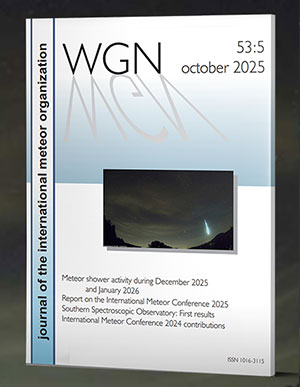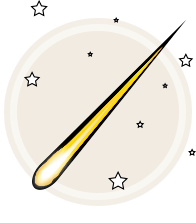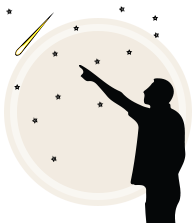The excellent conditions with a New Moon on July 1 were used by
many observers for monitoring the activity of the June Bootids
despite activity was not expected to be extra-ordinary. Nevertheless, the detection of a weak, but distinct annual activity was a
challenge for visual observing experts, too.
In 1998, the June Bootids produced an outburst of activity with
ZHRs near 80, possibly reaching 200, near a solar longitude of
95.7 degrees (J2000.0). The below Table gives an overview of the
activity of the June Bootids in 2000. No outburst was observed.
The apparent noise of ZHR values suggests a typical visual detection
limit of minor showers near ZHR=1. Significant activity was therefore
observed between June 27, 0400-2300 UT. This is about 0.3 to 0.8
degrees later (or 7 to 19 hours later) than in 1998. It will be
worthwhile to revisit previous moon-free years to confirm an annual
activity level of ZHR = 2 to 3.
The radiant position of the June Bootids was found to vary
considerably during detections in previous years back to 1916.
This could be a physical effect of orbital perturbations, but
is strongly enhanced by a purely geometrical effect: As the
meteoroids approach the Earth from behind, vectorial addition
with the motion of the Earth is very sensitive to slightest
orbital variations. (The reader may check this with vector
parallelograms.)
Additional uncertainties are thus being introduced if the actual
radiant position was not equal to what observers used for shower
association. It is strongly suggested to send in the details on
plotted meteors for a more thorough analysis. A first radiant
analysis of data obtained by ARLRA, BOJEV, RASLI, SAREL, VELVA,
MIHMI, YORYO in the observing camp at Avren, Bulgaria, delivers
a distinct source at alpha=215, delta=+47. Whereas the radiant
is sharply defined at its western edge, a “tail” of convergences
extends towards east from this position. The radiant position is
corrected for zenithal attraction and diurnal aberration.
---------------------------------------------------------- Date Time (UT), avg. Sollon nObs nIND nJBO ZHR +/- ---------------------------------------------------------- Jun 26 2300-0650 0250 94.81 6 3 2 1.3 0.8 Jun 26 2100-2300 2200 95.57 5 5 2 0.8 0.5 Jun 27 2300-0252 0040 95.68 9 5 4 1.3 0.6 Jun 27 0400-1102 0730 95.95 5 2 8 3.6 1.2 Jun 27 2010-2300 2135 96.51 10 8 14 1.9 0.5 Jun 27 2300-0020 2340 96.59 9 9 2 0.6 0.3 Jun 28 0300-0740 0520 96.82 6 2 4 1.2 0.6 Jun 28 2020-0100 2240 97.51 8 6 1 0.4 0.3 Jun 29 2010-2330 2150 98.43 4 3 0 0.4 0.4 ----------------------------------------------------------
Solar longitudes refer to equinox J2000.0. nObs is the number
of individual observing periods, nIND is the number of individual observers providing them, nJBO is the number of June Bootids
seen. The the radiant position was assumed at alpha=224, delta=+48,
the population index used wa r=2.2 as derived from the outburst in
1998. The extremely low meteor numbers require a careful statistical treatment. For a given meteor number, various true rates would
have been possible. The expectation value of the ZHR is, therefore,
the average of all these rates (the integral over the distribution
function) which are naturally all greater than or equal to 0. The
resuls is most obvious in the last row (June 29): 0 meteors could
have been caused by ZHRs between 0.0 and 0.8. The longer the observers keep seeing 0 meteors, the lower the expectation value for
ZHR. The actual small-number ZHR formula is
ZHR = (1 + sum nJBO) / sum(Teff/C),
where Teff is the effective observing time and C is the total
correction composed of limiting magnitude, clouds, and zenith
correction. Zenith attraction was not taken into account here;
most of the observing periods had radiant elevations hR>40 degrees.
We are grateful to the following observers for the quick submission
of data and careful shower association of their meteors:
ANTKA Karl Anthier (France), KACJA Javor Kac (Slovenia),
ARLRA Rainer Arlt (Germany), LINMI Mike Linnolt (USA),
ATAJU Jure Atanackov (Slovenia), LUNRO Robert Lunsford (USA),
BOJEV Eva Bojurova (Bulgaria), MARPI Pierre Martin (Canada),
BUCAN Andreas Buchmann (Switzerland), MIHMI Mihail Mihov (Bulgaria),
COOMA Mary Cook (UK), RASLI Lina Rashkova (Bulgaria),
DECGO Goedele Deconink (Belgium), SAREL Elena Sarbinska (Bulgaria),
GONRU Rui Goncalves (Portugal), STALE Leo Stachowicz (UK),
HALCA Cathy Hall (USA), VELVA Valentin Velkov (Bulgaria),
HAVRO Roberto Haver (Italy), VERJN Jan Verbert (Belgium),
JOHCA Carl Johannink (the Netherlands) and YORYA Yordan Yordanov (Bulgaria).




 You saw something bright and fast? Like a huge shooting star? Report it: it may be a fireball.
You saw something bright and fast? Like a huge shooting star? Report it: it may be a fireball.  You counted meteors last night? Share your results with us!
You counted meteors last night? Share your results with us!  You took a photo of a meteor or fireball? You have a screenshot of your cam? Share it with us!
You took a photo of a meteor or fireball? You have a screenshot of your cam? Share it with us!  You caught a meteor or fireball on video? Share your video with us!
You caught a meteor or fireball on video? Share your video with us!